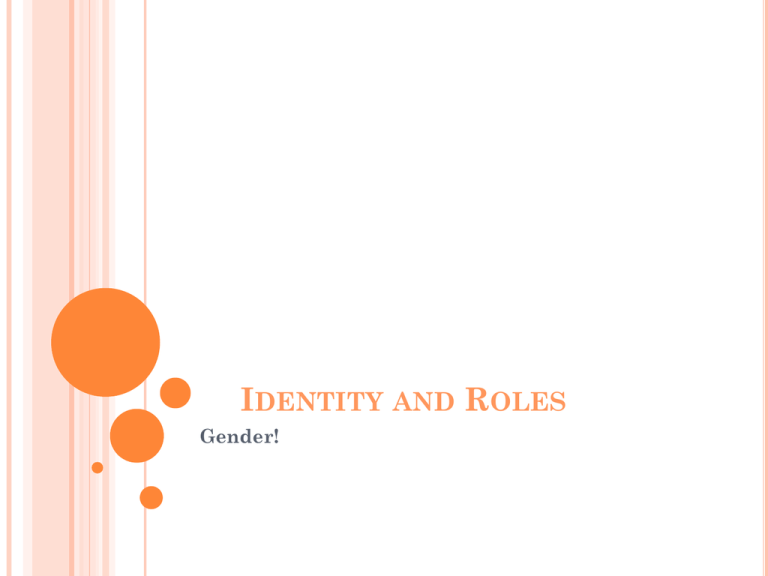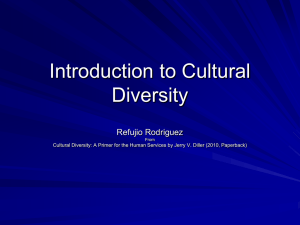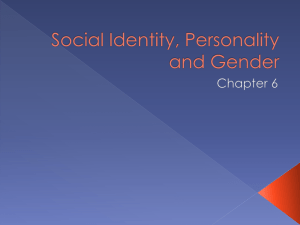
IDENTITY AND ROLES
Gender!
NATURE VS. NURTURE
HOW IS CULTURE OBTAINED?
•
Nurture: John Locke (1690) “An
Essay Concerning Human
Understanding”
–
•
Theory: A baby is a blank slate. Adult
personalities are exclusively the products
of post-birth experiences, which differ
from culture to culture.
Nature: Genetic Research
–
Some genes/gene combinations are
linked to human nature – To what extent
we are not yet sure.
NATURE VS. NURTURE
HOW IS CULTURE OBTAINED?
•
Today, Nature + Nurture:
Genetics (Nature) are responsible
for broad behavioral potentials and
limitations.
– Cultural values and expectations,
and life experiences –especially in
the early years (Nurture),
contribute more to the intricacies
of personality formation.
–
ENCULTURATION
EXACTLY WHAT IS PASSED DOWN FROM GENERATION
TO GENERATION, AND HOW IS IT DONE?
›
Self-Awareness
›
Concepts of the Environment (Worldview)
›
How: Childhood experiences, dependence and/or
Independence training,
Gender Concepts
›
How: Object orientation, spatial orientation, temporal
orientation and normative orientation.
Personality
›
How: Early positive reinforcement of the self via Mom,
family and peers. Personal naming.
How: Through ideas about Intersexuality, Transgender, and
the male/female gender split
Culturally Acceptable Behaviors
How: Through behaviors deemed normal/abnormal, what is
considered psychotic.
SELF-AWARENESS
Allows one to assume responsibility for
one’s conduct, to learn how to react
to others, and to assume a variety of
roles in society. Develops along with
neuromotor skills…
Early mother/family cultural
impressions
›
Modern industrial societies vs. smallscale farming/foraging communities
Examples…
SELF-AWARENESS
Modern industrial: Self-awareness
develops slowly (~2yrs old) perhaps
due to limited mother-to-infant contact.
Ex: (United States) Infant sleeps isolated from mother, does
not nurse as frequently, spends ~20% of time directly next
to mother. Positive correlation between longer
breastfeeding and higher cognitive test scores, lower risk of
attention deficit disorder, fewer allergies, ear infections and
diarrhea.
Small-scale farming/foraging
communities
Ex: Zhutwasi (San Bushmen) Infant sleeps with the
mother, is carried/held most (70%) of the time, and
frequently breast-feeds (~4 times an hour for 1-2 minutes).
SELF-AWARENESS
Personal Naming
›
Naming acknowledges a child’s birthright
and establishes its social identity. Without
a name, an individual has no identity, no
self. For this reason, most cultures have
naming ceremonies: A special event or
ritual to mark the naming of a child
Ex: Icelanders. A patrilineal society. A girl
would take her father’s first name (i.e. “Olaf”)
and add “dotter” on the end, creating
“Olafdotter” as her last name. A son would take
his father’s first name (i.e. “Sven”) and add
“sen” on the end, creating “Svensen” as his last
name.
CONCEPTS OF THE
ENVIRONMENT
(WORLDVIEW)
Object Orientation
Spatial Orientation
Temporal Orientation
Normative Orientation
When confronted with uncertainty,
humans must clarify and give structure
to the situation. Cultures construct
explanations of the universe, and every
culture has a different view, a different
cultural lens.
CONCEPTS OF THE
ENVIRONMENT
(WORLDVIEW)
Object Orientation
›
Cultures single out for attention
certain environmental features,
while ignoring others or lumping
them together into broad
categories
Ex: What objects could be labeled
“household” items? Of the category
we term “animals”, which are the
most important to us? Why?
CONCEPTS OF THE
ENVIRONMENT
(WORLDVIEW)
Spatial Orientation
›
Names and significant features of
places.
Ex: “Plymouth” is located at the “Mouth” of
the river “Plym”
Ex: “Mediterranean” (Greek) means
“Between” the “Lands” (of
Egypt/Greece/Troy).
Ex: How to direct someone to Interstate 280?
CONCEPTS OF THE
ENVIRONMENT
(WORLDVIEW)
Temporal Orientation
›
Connecting past actions with those
of the present and future provides
a sense of self-continuity.
Ex: How old are you? How (by which units)
do you measure this? At which age are you
no longer a child? When would you consider
yourself ready for retirement?
CONCEPTS OF THE
ENVIRONMENT
(WORLDVIEW)
Normative Orientation
›
How to morally gauge your own
actions or those of others. How to
evaluate yourself based on
culturally transmitted ideals,
moral values and principles.
Ex: Why would taking and then permanently
keeping your neighbor’s garden hose without
asking, be considered wrong?
PERSONALITY
Personalities are products of enculturation, as
experienced by individuals, each with his or
her distinctive genetic makeup
Culture + Genetic makeup = Personality
›
Culture is like a mask. Gradually the “mask” of
culture as it is “placed” on the face of the child,
begins to shape that person until there is little
sense of the mask as a superimposed alien force.
Instead it feels natural, as if one were born with
it. The individual has successfully internalized
the culture.
PERSONALITY
Dependence vs. Independence
training
›
Dependence Training: Child-rearing
practices that foster compliance in the
performance of assigned tasks and
dependence on the domestic group, rather
than reliance on oneself.
PERSONALITY
In Dependence Training, the individual
is subordinate to the group. Community
wishes and ideas have more weight than
an individual’s.
Selfish/aggressive behavior actively
discouraged.
Family members all actively work to help
and support one another. Characteristic of
societies with an economy based on
subsistence farming, or in foraging
societies in which many family groups live
together.
PERSONALITY
Dependence vs. Independence
training
›
Independence Training: Childrearing practices that foster
independence, self-reliance, and personal
achievement.
PERSONALITY
Independence Training is characteristic of
societies in which a basic unit of parent(s) and
offspring fends for itself.
Typically found in trading and industrial
societies. Babies are more separated from the
mother.
Children typically not given tasks/chores until
later childhood. These tasks are usually
carried out for personal benefit (i.e. for an
allowance) rather than contributions to the
family’s welfare.
Competition and winning are emphasized in
school and life. Displays of individual will,
assertiveness, and even aggression encouraged.
PERSONALITY
MODAL PERSONALITY
Those
character traits that
occur with the highest
frequency in a social group
and are therefore the most
representative of a culture
Statistical concept
How more complex societies
organize diversity and how
diversity related to cultural
change
Data on Modal Personality
gathered via tests like the
Rorschach test
Life histories and dreams,
analyzing popular tales, jokes,
legends, and traditional myths
GENDER CONCEPTS
Biology: Sex is determined according
to whether a person’s 23rd
chromosomal set is XX (female) or
XY (male). People born without one
or the other, or with a mutation on
the X or Y chromosome do not fit
neatly into the male/female gender
split.
GENDER CONCEPTS
›
Intersexual: A person born with
reproductive organs, genitalia, and/or sex
chromosomes that are not exclusively male
or female.
›
1% of all humans (60 million people)
Transgender: A person who crosses over or
occupies a culturally accepted position in the
binary male-female gender construction.
Winkte: Among the Lakota, a third recognized
gender, accorded considerable prestige in their
communities.
GENDER CONCEPTS
Acceptance/Importance of people who
are intersexed varies culturally
›
Greece/Ottoman Empire (~1500 years
ago)
›
India
›
Eunuchs: Castrated male individuals. The term
means “guardian of the bed” in Greek. Ottoman
Empire: Were in charge of harems, but also
occupied valued position such as priests,
administrators and army commanders.
Hijra (also called Eunuchs)
People who are Intersexual/Transgender
widely accepted in Western Society?
Issues over Gay Marriage
Changing sex
CULTURALLY ACCEPTABLE BEHAVIORS
What is considered normal and
acceptable in one society may be
abnormal and unacceptable
(ridiculous, shameful, and sometimes
criminal) in another).
CULTURALLY ACCEPTABLE BEHAVIORS
Some cultures tolerate or accept a
much wider range of diversity than
others and may even accord special
status to the deviant or eccentric as
unique, extraordinary, even sacred.
Examples…
CULTURALLY ACCEPTABLE BEHAVIORS
›
Ex: (ancient Egypt) Dwarfs and the Blind.
If one had Achondroplasia: Associated with the
protective God Bes (below far right) and were
revered for their jewelry-making skills (above)
If an individual was blind, playing the harp was
destiny
CULTURALLY ACCEPTABLE BEHAVIORS
›
Ex: (North America) the Manic and
Hyperactivity
More and more viewed as assets in the
quest for success.
“Finely wired, exquisitely alert nervous
systems”, able to make one highly
Sensitive to signs of change, able to fly
from one thing to another while pushing
the limits of everything and doing it all
with an intense level of energy focused
totally on the future.
CULTURALLY ACCEPTABLE BEHAVIORS
Culture-bound syndrome: A
mental disorder specific to a
particular culture.
›
Windigo among northern Algonquian Indian
groups: Individuals afflicted by the psychosis
developed the delusion that, falling under the
control of these monsters they were themselves
transformed into Windigos, with a craving for
human flesh. Although there are no known
instances where sufferers of Windigo psychosis
actually ate another human being they were
acutely afraid of doing so, and people around
them were genuinely fearful that they might.
CULTURALLY ACCEPTABLE BEHAVIORS
Culture-bound syndrome: A
mental disorder specific to a
particular culture.
›
Paranoid Schizophrenia among
Euramerican cultures: Characterized by
feelings of persecution from others, a
withdrawal of the individual from
society, a fear and mistrust of nearly
everyone.
CULTURALLY ACCEPTABLE BEHAVIORS
Culture-bound syndrome: A
mental disorder specific to a
particular culture.
›
Both of the previous examples draw upon
whatever imagery and symbolism their culture
has to offer. Northern Algonquian culture, this
includes myths featuring cannibal giants. Irish
Schizophrenia draws on Saints/Virgin Mary
imagery. In secular Euramerica, this includes
more non-religious persecution ideas.









